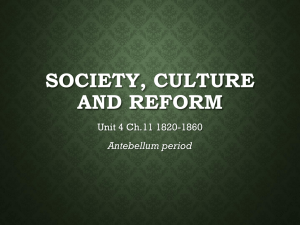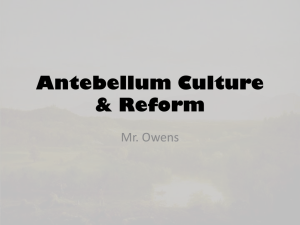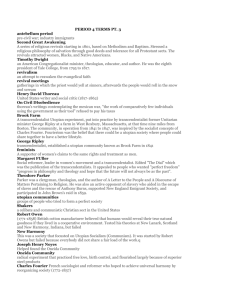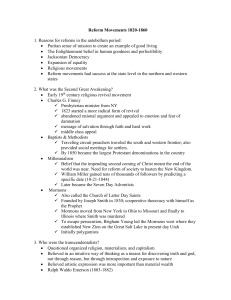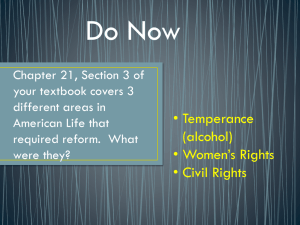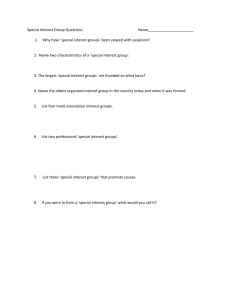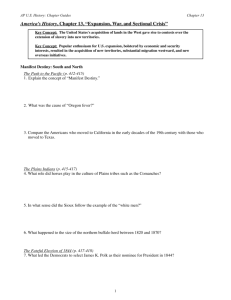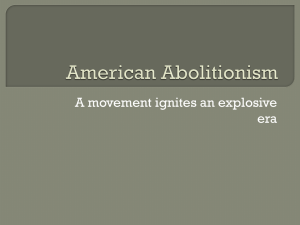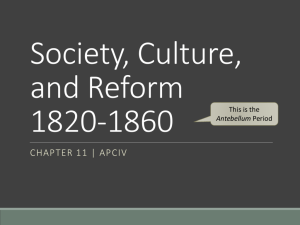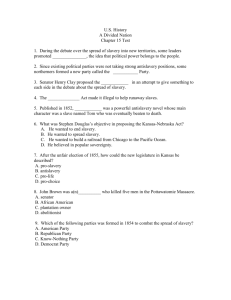20bFerment of Reform
advertisement
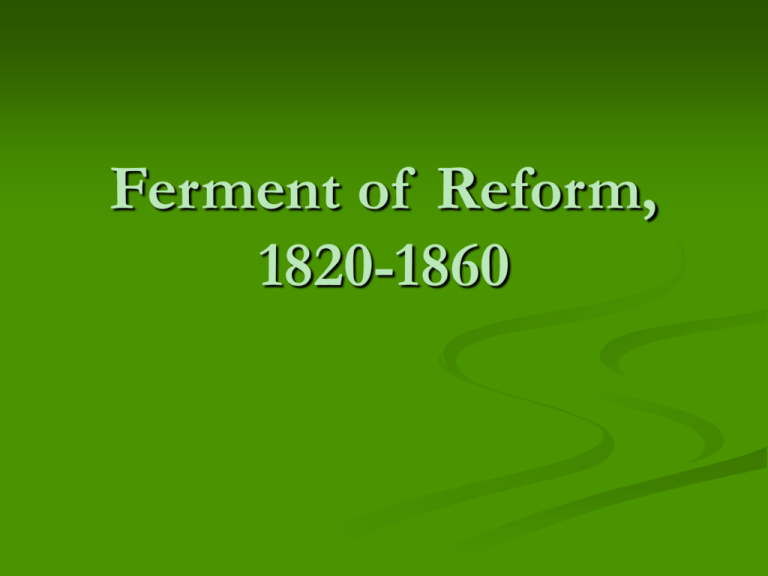
Ferment of Reform, 1820-1860 Second Great Awakening Second Great Awakening • Early 19th Century religious revivals – Calvinist reaction against rationalism – 1795, Reverend Timothy Dwight, president Yale College began a series of campus revivals • 1832, Presbyterian minister Charles Finney, upstate New York – – – – More radical form of revivalism Appealed to people’s emotions & fear All were free to be saved through faith & hard work Western New York “burned-over district” from “fireand-brimstone” revivals Second Great Awakening • South – Itinerant Baptist & Methodist preachers like Peter Cartwright – 1850, Baptists & Methodists largest protestant denominations • Millennialism – Widespread belief that world was about to end – William Miller • Predicted world’s end on October 21, 1844 • Millerites would become Seventh-Day Adventists Mormons • Founded by Joseph Smith, 1830, in NY • Based on Book of Mormon • Connected Indians to lost tribes of Israel – Gained followers moved from NY to OH, MO, & IL where Smith was murdered • Brigham Young moved Mormons to Utah • Belief in polygamy set U.S. government against them The Transcendentalists • Questioned the doctrines of established • • • • • churches & capitalistic habits of merchant class Argued for a mystical & intuitive way of thinking to discover one’s inner self Looked for the essence of God in nature Challenged materialism; artistic expression more important than pursuit of wealth Highly individualistic; viewed organized institutions as unimportant Supported a variety of reforms; especially antislavery Ralph Waldo Emerson (1803-1882) • Popular lecturer • Wrote essays & poems • Urged Americans not to imitate European culture, but to create an American culture • His essays & poems argued for selfreliance, independent thinking, & the primacy of spiritual manners over material ones • Leading critic of slavery & Union supporter during the Civil War Henry David Thoreau (1817-1862) • Conducted 2-year experiment of living in woods alone to discover essential truths about life – Walden (1854) • Advocated non-violent protest in essay “On Civil Disobedience” – Sent to jail for refusing to pay a tax that might be used to fight an “immoral” war—the Mexican War (1846-1848) Brook Farm • 1841, George Ripley, protestant minister • Communal experiment on Brook Farm • To achieve “a more natural union between intellectual and manual labor.” • Some leading intellectuals lived there – Emerson, feminist Margaret Fuller, & Nathaniel Hawthorne • Ended in 1849 after a bad fire & due to heavy debts Communal Experiments Shakers 6000 members by 1840s Held property in common Men & women kept separate; marriage & sex forbidden Died out by mid-1900s due to lack of members New Harmony, Indiana Founded by industrialist & reformer Robert Owen Hoped to solve inequity & alienation caused by Industrial Revolution Failed because of financial problems & disagreements Communal Experiments Oneida, New York 1848 by John Humphrey Noyes Members shared property & marriage partners Critics attacked as sinful experiment in “free love” Community prospered economically by producing highquality silverware Fourier Phalanxes, 1840s French socialist Charles Fourier advocated sharing work & living arrangements called Fourier Phalanxes Movement died out quickly Arts & Literature • Painting – Genre painting—portraying the everyday life of ordinary people • George Caleb Bingham, William S. Mount • Thomas Cole, Frederick Church – Hudson River School » Expressed romantic age’s fascination with the natural world • Architecture – American architects adapted classical Greek styles to glorify the democratic spirit Arts & Literature • Literature – After War of 1812 American authors with American themes – Washington Irving, James Fenimore Cooper, Nathanial Hawthorne, Herman Melville Reforming Society Temperance 1820 rate of alcohol consumption 5 gallons liquor/per person 1826 American Temperance Society founded – 1840 Washingtonians, recovering alcoholics – Used moral arguments to persuade drinkers to take a pledge of total abstinence Argued alcoholism a disease that needed treatment 1840s over a million members of temperance societies German & Irish immigrants opposed but lacked political power 1851 Maine first of 13 states to prohibit liquor before Civil War Lost steam prior to and during Civil War Gained again in 1870s—Women’s Christian Temperance Union – 18th Amendment in 1919 Reforms for the disabled & prisoners Dorothea Dix horrified that mentally ill were in prison with criminals – – Dedicated her life to improving life for mentally ill 1840s she convinced many state legislatures to build mental hospitals Thomas Gallaudet founded school for the deaf Dr. Gridley Howe school for the blind Penitentiaries replaced prisons experimented with solitary confinement, structure, & discipline Public Education Horace Mann leader of the public school movement (MA) Advocated improving schools, compulsory attendance, longer school year, & better teacher preparation 1840s movement for tax-supported schools spread to other states William Holmes McGuffey McGuffey Readers textbooks that taught reading along with moral instruction Extolled virtues of hard work, punctuality, & sobriety Catholics started private schools in response to the Protestant tone of public schools Public Education 1830s Protestant denominations founded several new colleges Some colleges began accepting women Changing American Family Changing American Family Cities & industrialization changed roles of men & women Men worked; women stayed home Birthrate fell; size of families diminished Cult of domesticity Idealized view of women as moral leaders in the home & teacher of children Women’s rights movement Women involved in anti-slavery movement discriminated against by men in the movement Sarah & Angelina Grimke objected Angelina wrote Letter on the Condition of Women and the Equality of the Sexes (1837) Lucretia Mott & Elizabeth Cady Stanton Seneca Falls Convention, NY (1848) 1st women’s rights convention in U.S. “Declaration of Sentiments” All men & women created equal Listed women’s grievances Women’s rights movement Elizabeth Cady Stanton & Susan B. Anthony Leaders after Seneca Falls Equal voting, legal & property rights for women 1850s—Civil War women’s movement overshadowed by slavery Antislavery Movement American Colonization Society, 1817 Free slaves & transport them to Africa Appealed to moderate antislavery reformers & politicians Large number of whites wanted to remove blacks from U.S. society 1822 established Monrovia, Liberia 1820-1860 12,000 blacks moved to Africa while # of slaves grew from 1.5 to 4 million American Antislavery Society William Lloyd Garrison – 1831 The Liberator – Beginning of the radical abolitionist movement – Called for the immediate abolition of slavery 1833 Garrison & others founded American Antislavery Society Garrison burned Constitution as a proslavery document Liberty party Garrison’s radicalism led to a split in the abolitionist movement 1840 Liberty party was formed for political action as opposed to a moral crusade – James Birney candidate for president, 1840 & 1844 – One campaign pledge: to bring an end to slavery by political & legal means Black Abolitionists Escaped slaves & free blacks outspoken critics of slavery – Frederick Douglass – Harriet Tubman – David Ruggles – Sojourner Truth – William Still Many organized effort to assist fugitive slaves – Underground Railroad
